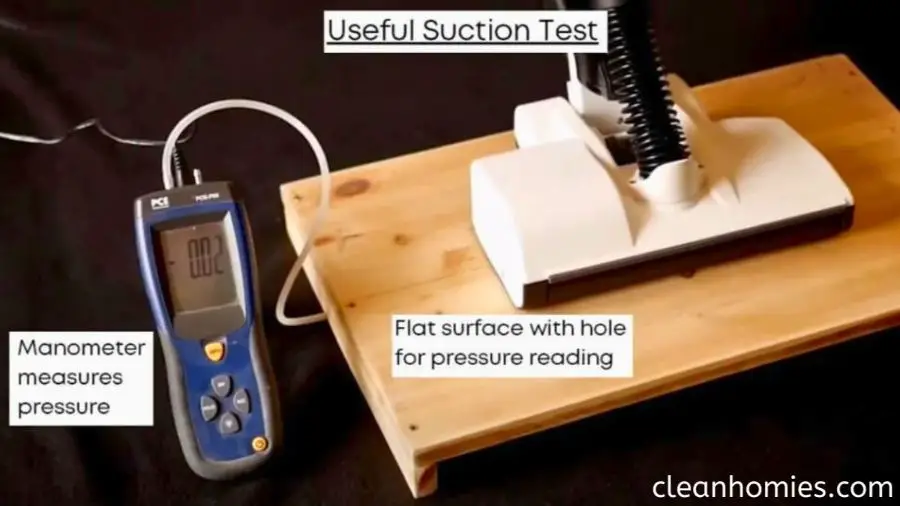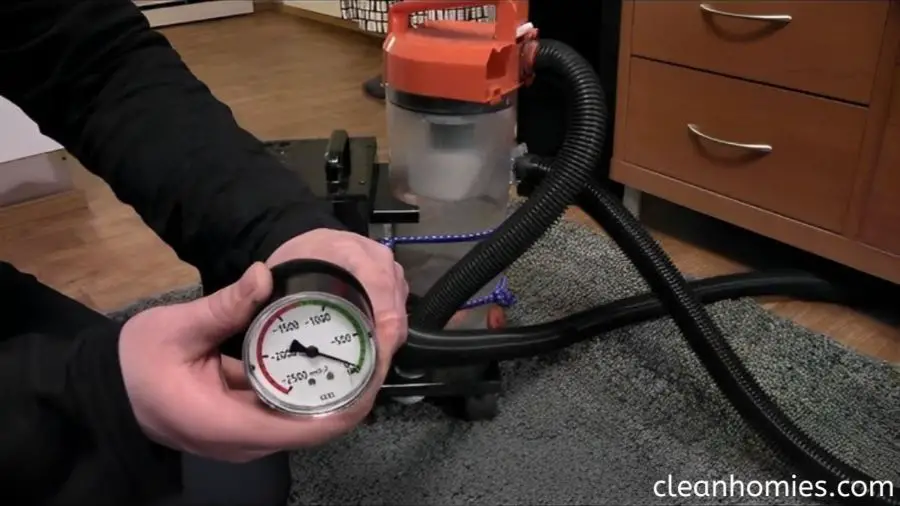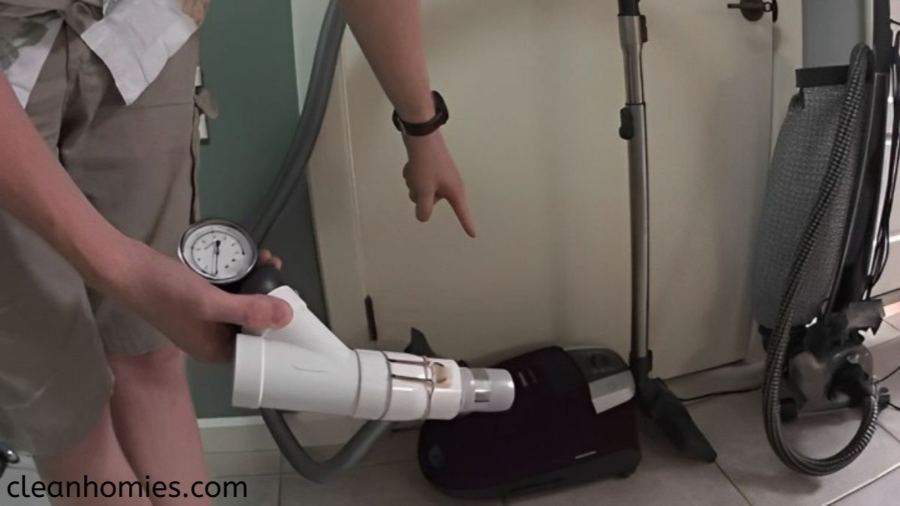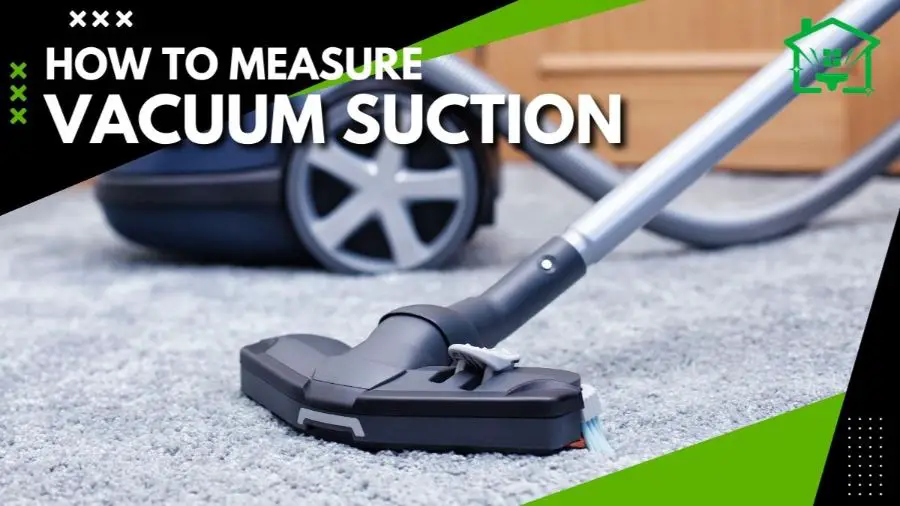According to The American Society for Testing and Materials (ASTM), airwatts are the best way to measure vacuum suction.
Here’s the formula for the same:
Air Flow (in cubic feet per minute) x suction in water lift
However, other factors like nozzle design and filter type are also important to determine how powerful the vacuum will be against household dust.
Continue reading for three different methods to measure vacuum suction.
👉How Do You Measure the Suction Power of a Vacuum?
🫙Sealed Container Method

Things You Need
Steps To This Method
➗Air Watts

The American Society of Testing and Materials (ASTM) considers Air Watts the most accurate measure for vacuum suction.
This uses airflow and suction together to measure the vacuum suction, where the airflow is measured in CFM (cubic feet per minute) and suction is measured by water lift.
Air watt is obtained by multiplying the amount of suction (in inches of water lift) by the amount of airflow (in CFM).
The relation is simple: more air watts equals more suction.
📏AirFlow Meter

You can also measure airflow using a Baird Air Flow Meter. It primarily functions with specific vacuum models (Kirby’s) but is versatile for many other applications.
You can buy a Baird Air Flow Meter from a local vacuum shop or on sites like eBay or Amazon.
Here’s the relationship of airflow with the vacuum’s raw suction performance:
Airflow is the movement or circulation of air within a specified space. It is the volume of air that moves through a specific area within a specific period, often measured in units like Cubic Feet per Minute (CFM).
Airflow is affected by factors including resistance, air turbulence, hose width, and restriction in the path.
So, again, more airflow equals better raw cleaning performance.
Airflow is a practical measuring method as it accounts for the vacuum motor’s power and the resistance of the bag/filter when air passes through.
However, it does not account for the raw pull strength of the vacuum.
To measure airflow, you generally have to remove the hose and other tools/attachments and then use the Airflow meter. So, it’s not a definitive way to measure overall vacuum performance in cleaning household dust.
💦Water Lift Method

In the water lift method to measure suction, airflow is not accounted for as water creates a sealed suction, and we can measure the true suction force.
Suppose you connect a hose with a diameter of two inches to a water-filled column of equal diameter.
In that case, you can measure the water lift value by finding the maximum height you can draw up the water within the column.
This gives you a measurement of the pure suction force the vacuum can produce to lift off the dirt from a surface, but because of the absence of airflow, you can not determine how effective its cleaning ability is.
Note:
If you want to calculate air watts, the vacuum reading you take of the water lift should be in inches.
Also Read: Is Vacuuming Sawdust OK?
💡How to Measure Vacuum Suction? FAQs
What units measure vacuum suction?
The most accurate unit to measure vacuum suction is air watts. Other common units of measurement are mm Hg, Pa, kPa, PSI, Torr and bar.
What is a good suction power for a vacuum cleaner?
The minimum amount of suction power a vacuum should have depends on the type of vacuum cleaner: upright, cordless, etc. One hundred air watts is the minimum required power for an upright vacuum cleaner.
Does higher CFM mean better suction?
High CFM does not necessarily mean better suction as it does not reflect factors like air turbulence and resistance.
CFM values measure airflow, but it does not indicate if a vacuum can better pull deep-seated dirt in a carpet.
You should also know about the water lift of the vacuum to have a more accurate measurement.
Does higher wattage in a vacuum mean better suction?
Wattage is only a measure of how much electrical power a vacuum consumes. It tells us nothing about suction power.
Air watt is a better unit to measure suction power or vacuum cleaner performance.
What specs should I look for in a vacuum cleaner?
For technical specifications, look into vacuum’s:
1. Suction power
2. Maximum airflow
3. Filter area
4. Bin size and
5. Noise level
Also, look for the design specs like weight and height so you can easily move and store the vacuum.
Lastly, know what floor type you have to clean to find a perfect vacuum for your needs.

Adarsh is a Health Science graduate with expertise in environmental health and wellness. He is a Neat Freak who constantly looks for ways to keep his surroundings clean. At Clean Homies, Adarsh is focused on researching and sharing information on how you can maintain hygiene at home for a happy life.

